2018 NISSAN NV PASSENGER VAN turn signal
[x] Cancel search: turn signalPage 268 of 426
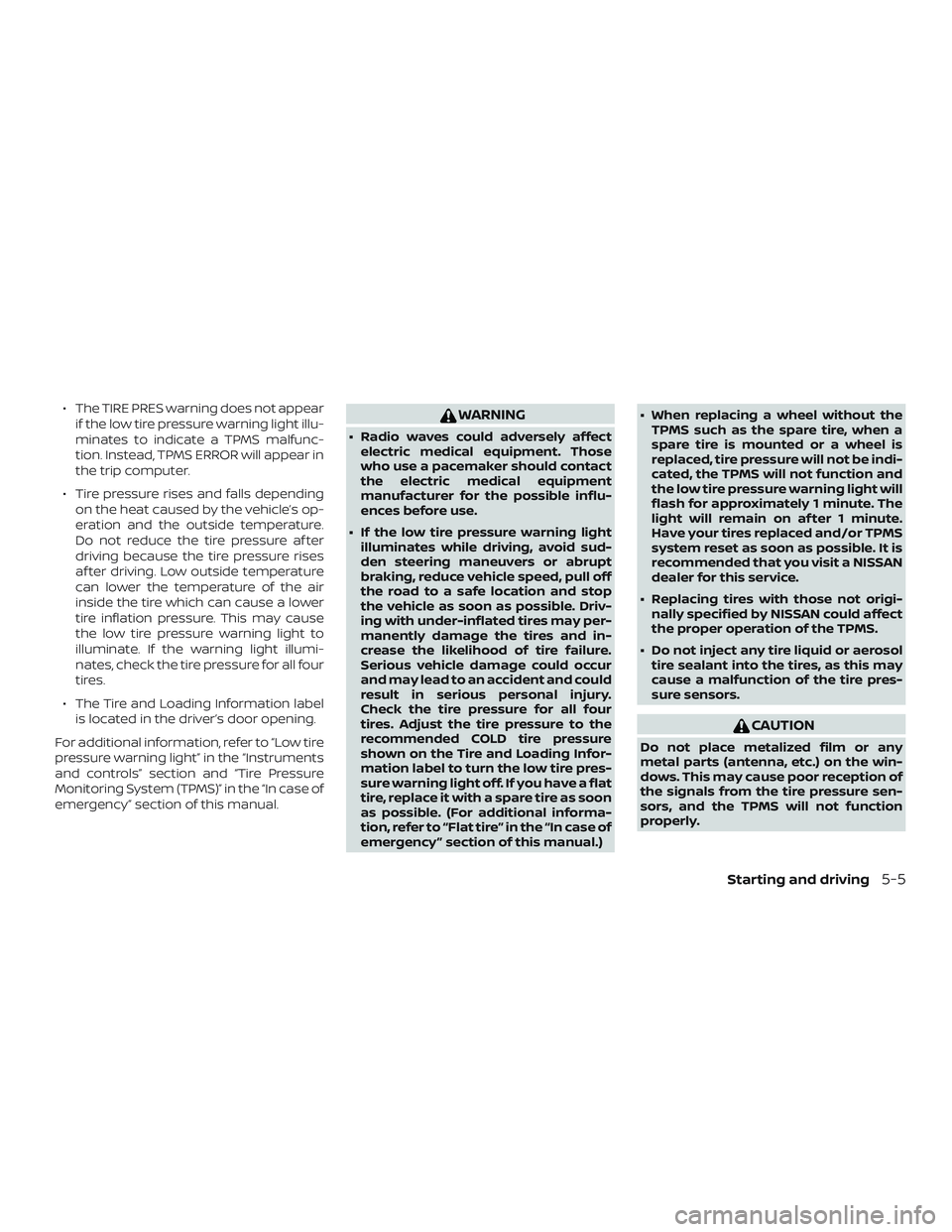
∙ The TIRE PRES warning does not appearif the low tire pressure warning light illu-
minates to indicate a TPMS malfunc-
tion. Instead, TPMS ERROR will appear in
the trip computer.
∙ Tire pressure rises and falls depending on the heat caused by the vehicle’s op-
eration and the outside temperature.
Do not reduce the tire pressure af ter
driving because the tire pressure rises
af ter driving. Low outside temperature
can lower the temperature of the air
inside the tire which can cause a lower
tire inflation pressure. This may cause
the low tire pressure warning light to
illuminate. If the warning light illumi-
nates, check the tire pressure for all four
tires.
∙ The Tire and Loading Information label is located in the driver’s door opening.
For additional information, refer to “Low tire
pressure warning light” in the “Instruments
and controls” section and “Tire Pressure
Monitoring System (TPMS)” in the “In case of
emergency” section of this manual.WARNING
∙ Radio waves could adversely affect electric medical equipment. Those
who use a pacemaker should contact
the electric medical equipment
manufacturer for the possible influ-
ences before use.
∙ If the low tire pressure warning light illuminates while driving, avoid sud-
den steering maneuvers or abrupt
braking, reduce vehicle speed, pull off
the road to a safe location and stop
the vehicle as soon as possible. Driv-
ing with under-inflated tires may per-
manently damage the tires and in-
crease the likelihood of tire failure.
Serious vehicle damage could occur
and may lead to an accident and could
result in serious personal injury.
Check the tire pressure for all four
tires. Adjust the tire pressure to the
recommended COLD tire pressure
shown on the Tire and Loading Infor-
mation label to turn the low tire pres-
sure warning light off. If you have a flat
tire, replace it with a spare tire as soon
as possible. (For additional informa-
tion, refer to “Flat tire” in the “In case of
emergency ” section of this manual.) ∙ When replacing a wheel without the
TPMS such as the spare tire, when a
spare tire is mounted or a wheel is
replaced, tire pressure will not be indi-
cated, the TPMS will not function and
the low tire pressure warning light will
flash for approximately 1 minute. The
light will remain on af ter 1 minute.
Have your tires replaced and/or TPMS
system reset as soon as possible. It is
recommended that you visit a NISSAN
dealer for this service.
∙ Replacing tires with those not origi- nally specified by NISSAN could affect
the proper operation of the TPMS.
∙ Do not inject any tire liquid or aerosol tire sealant into the tires, as this may
cause a malfunction of the tire pres-
sure sensors.
CAUTION
Do not place metalized film or any
metal parts (antenna, etc.) on the win-
dows. This may cause poor reception of
the signals from the tire pressure sen-
sors, and the TPMS will not function
properly.
Starting and driving5-5
Page 299 of 426

Push the switch on to warn other drivers
when you must stop or park under emer-
gency conditions. All turn signal lights flash.
WARNING
∙ If stopping for an emergency, be sureto move the vehicle well off the road.
∙ Do not use the hazard warning flash- ers while moving on the highway un-
less unusual circumstances force you
to drive so slowly that your vehicle
might become a hazard to other
traffic. ∙ Turn signals do not work when the
hazard warning flasher lights are on.
The flashers will operate with the ignition
switch placed in any position.
Some jurisdictions may prohibit the use
of the hazard warning flasher switch
while driving.
TIRE PRESSURE MONITORING
SYSTEM (TPMS)
This vehicle is equipped with TPMS. It moni-
tors tire pressure of all tires except the
spare. When the low tire pressure warning
light is lit, and the TIRE PRES warning ap-
pears in the trip computer, one or more of
your tires is significantly under-inflated.
Press the INFO knob on the instrument
panel located behind the steering wheel
for information about location(s) and pres-
sure(s) of the under-inflated tire(s). If the
vehicle is being driven with low tire pres-
sure, TPMS will activate and warn you of it
by the low tire pressure warning light. This
system will activate only when the vehicle
is driven at speeds above 16 mph (25 km/h).
For additional information, refer to “Warn-
ing lights, indicator lights and audible re-
minders” in the “Instruments and controls”
section, and “Tire Pressure Monitoring Sys-
tem (TPMS)” in the “Starting and driving”
section of this manual.
LIC0394
HAZARD WARNING FLASHER SWITCH FLAT TIRE
6-2In case of emergency
Page 300 of 426
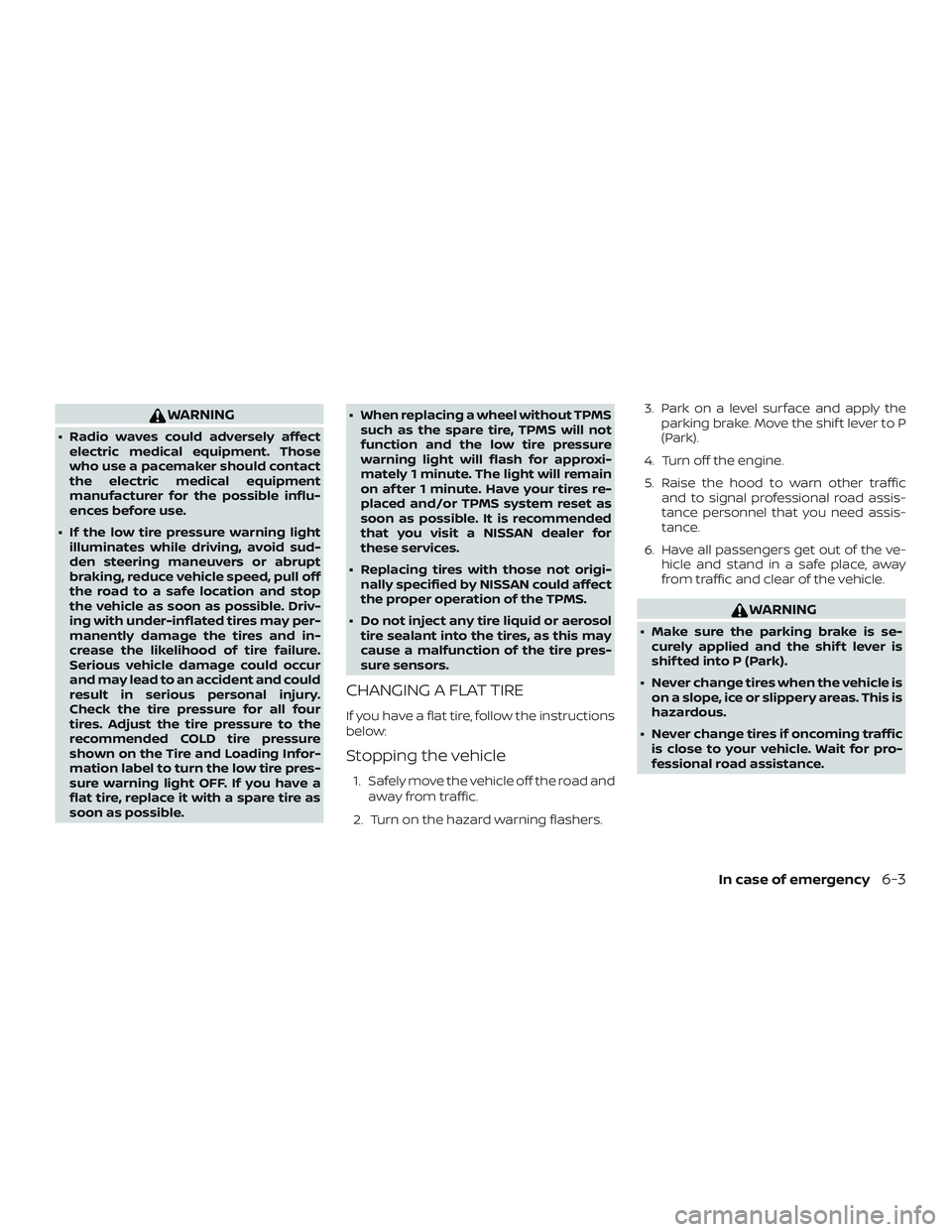
WARNING
∙ Radio waves could adversely affectelectric medical equipment. Those
who use a pacemaker should contact
the electric medical equipment
manufacturer for the possible influ-
ences before use.
∙ If the low tire pressure warning light illuminates while driving, avoid sud-
den steering maneuvers or abrupt
braking, reduce vehicle speed, pull off
the road to a safe location and stop
the vehicle as soon as possible. Driv-
ing with under-inflated tires may per-
manently damage the tires and in-
crease the likelihood of tire failure.
Serious vehicle damage could occur
and may lead to an accident and could
result in serious personal injury.
Check the tire pressure for all four
tires. Adjust the tire pressure to the
recommended COLD tire pressure
shown on the Tire and Loading Infor-
mation label to turn the low tire pres-
sure warning light OFF. If you have a
flat tire, replace it with a spare tire as
soon as possible. ∙ When replacing a wheel without TPMS
such as the spare tire, TPMS will not
function and the low tire pressure
warning light will flash for approxi-
mately 1 minute. The light will remain
on af ter 1 minute. Have your tires re-
placed and/or TPMS system reset as
soon as possible. It is recommended
that you visit a NISSAN dealer for
these services.
∙ Replacing tires with those not origi- nally specified by NISSAN could affect
the proper operation of the TPMS.
∙ Do not inject any tire liquid or aerosol tire sealant into the tires, as this may
cause a malfunction of the tire pres-
sure sensors.
CHANGING A FLAT TIRE
If you have a flat tire, follow the instructions
below:
Stopping the vehicle
1. Safely move the vehicle off the road and
away from traffic.
2. Turn on the hazard warning flashers. 3. Park on a level surface and apply the
parking brake. Move the shif t lever to P
(Park).
4. Turn off the engine.
5. Raise the hood to warn other traffic and to signal professional road assis-
tance personnel that you need assis-
tance.
6. Have all passengers get out of the ve- hicle and stand in a safe place, away
from traffic and clear of the vehicle.
WARNING
∙ Make sure the parking brake is se-curely applied and the shif t lever is
shif ted into P (Park).
∙ Never change tires when the vehicle is on a slope, ice or slippery areas. This is
hazardous.
∙ Never change tires if oncoming traffic is close to your vehicle. Wait for pro-
fessional road assistance.
In case of emergency6-3
Page 368 of 426

secondary latch keeps the hood from
opening when the primary latch is re-
leased.
When driving in areas using road salt or
other corrosive materials, check lubrica-
tion frequently.
Lights*:Clean the headlights on a regular
basis. Make sure that the headlights, stop
lights, tail lights, turn signal lights, and other
lights are all operating properly and in-
stalled securely. Also check headlight aim.
Road wheel nuts (lug nuts)*: When check-
ing the tires, make sure no wheel nuts are
missing, and check for any loose wheel
nuts. Tighten if necessary.
Tire rotation*: Tires should be rotated ev-
ery 5,000 miles (8,000 km).
Tires*: Check the pressure with a gauge
of ten and always prior to long distance
trips. If necessary, adjust the pressure in all
tires, including the spare, to the pressure
specified. Check carefully for damage, cuts
or excessive wear.
Tire Pressure Monitoring System (TPMS)
transmitter components: Replace the
TPMS transmitter grommet seal, valve core
and cap when the tires are replaced due to
wear or age. Wheel alignment and balance:
If the ve-
hicle should pull to either side while driving
on a straight and level road, or if you detect
uneven or abnormal tire wear, there may
be a need for wheel alignment. If the steer-
ing wheel or seat vibrates at normal high-
way speeds, wheel balancing may be
needed.
For additional information regarding tires,
refer to “Important Tire Safety Information”
(US) or “Tire Safety Information” (Canada) in
the Warranty Information Booklet.
Windshield: Clean the windshield on a
regular basis. Check the windshield at least
every six months for cracks or other dam-
age. Have a damaged windshield repaired
by a qualified repair facility.
Windshield wiper blades*: Check for
cracks or wear if they do not wipe properly.
Inside the vehicle
The maintenance items listed here should
be checked on a regular basis, such as
when performing scheduled maintenance,
cleaning the vehicle, etc. Accelerator pedal:
Check the pedal for
smooth operation and make sure the
pedal does not catch or require uneven
effort. Keep the floor mat away from the
pedal.
Automatic transmission P (Park) mecha-
nism: On a fairly steep hill check that the
vehicle is held securely with the shif t lever
in the P (Park) position without applying any
brakes.
Brake pedal: Check the pedal for smooth
operation. If the brake pedal suddenly goes
down further than normal, the pedal feels
spongy or the vehicle seems to take longer
to stop, have your vehicle checked imme-
diately. It is recommended that you visit a
NISSAN dealer for this service. Keep the
floor mat away from the pedal.
Brakes: Check that the brakes do not pull
the vehicle to one side when applied.
Parking brake: Check the parking brake
operation regularly. The vehicle should be
securely held on a fairly steep hill with only
the parking brake applied. If the parking
brake needs adjustment, it is recom-
mended that you visit a NISSAN dealer for
this service.
Maintenance and schedules9-3
Page 407 of 426
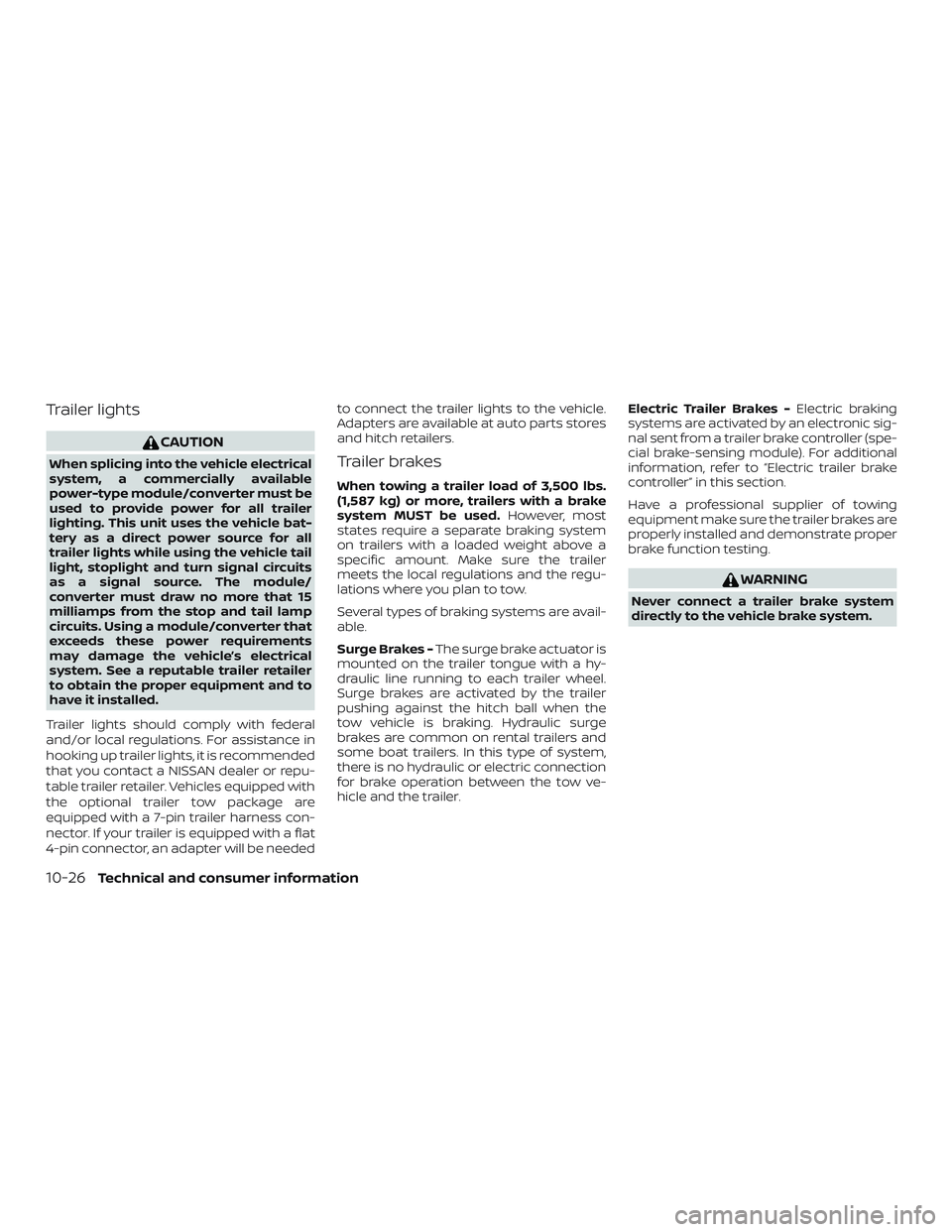
Trailer lights
CAUTION
When splicing into the vehicle electrical
system, a commercially available
power-type module/converter must be
used to provide power for all trailer
lighting. This unit uses the vehicle bat-
tery as a direct power source for all
trailer lights while using the vehicle tail
light, stoplight and turn signal circuits
as a signal source. The module/
converter must draw no more that 15
milliamps from the stop and tail lamp
circuits. Using a module/converter that
exceeds these power requirements
may damage the vehicle’s electrical
system. See a reputable trailer retailer
to obtain the proper equipment and to
have it installed.
Trailer lights should comply with federal
and/or local regulations. For assistance in
hooking up trailer lights, it is recommended
that you contact a NISSAN dealer or repu-
table trailer retailer. Vehicles equipped with
the optional trailer tow package are
equipped with a 7-pin trailer harness con-
nector. If your trailer is equipped with a flat
4-pin connector, an adapter will be needed to connect the trailer lights to the vehicle.
Adapters are available at auto parts stores
and hitch retailers.Trailer brakes
When towing a trailer load of 3,500 lbs.
(1,587 kg) or more, trailers with a brake
system MUST be used.
However, most
states require a separate braking system
on trailers with a loaded weight above a
specific amount. Make sure the trailer
meets the local regulations and the regu-
lations where you plan to tow.
Several types of braking systems are avail-
able.
Surge Brakes - The surge brake actuator is
mounted on the trailer tongue with a hy-
draulic line running to each trailer wheel.
Surge brakes are activated by the trailer
pushing against the hitch ball when the
tow vehicle is braking. Hydraulic surge
brakes are common on rental trailers and
some boat trailers. In this type of system,
there is no hydraulic or electric connection
for brake operation between the tow ve-
hicle and the trailer. Electric Trailer Brakes -
Electric braking
systems are activated by an electronic sig-
nal sent from a trailer brake controller (spe-
cial brake-sensing module). For additional
information, refer to “Electric trailer brake
controller” in this section.
Have a professional supplier of towing
equipment make sure the trailer brakes are
properly installed and demonstrate proper
brake function testing.
WARNING
Never connect a trailer brake system
directly to the vehicle brake system.
10-26Technical and consumer information
Page 420 of 426
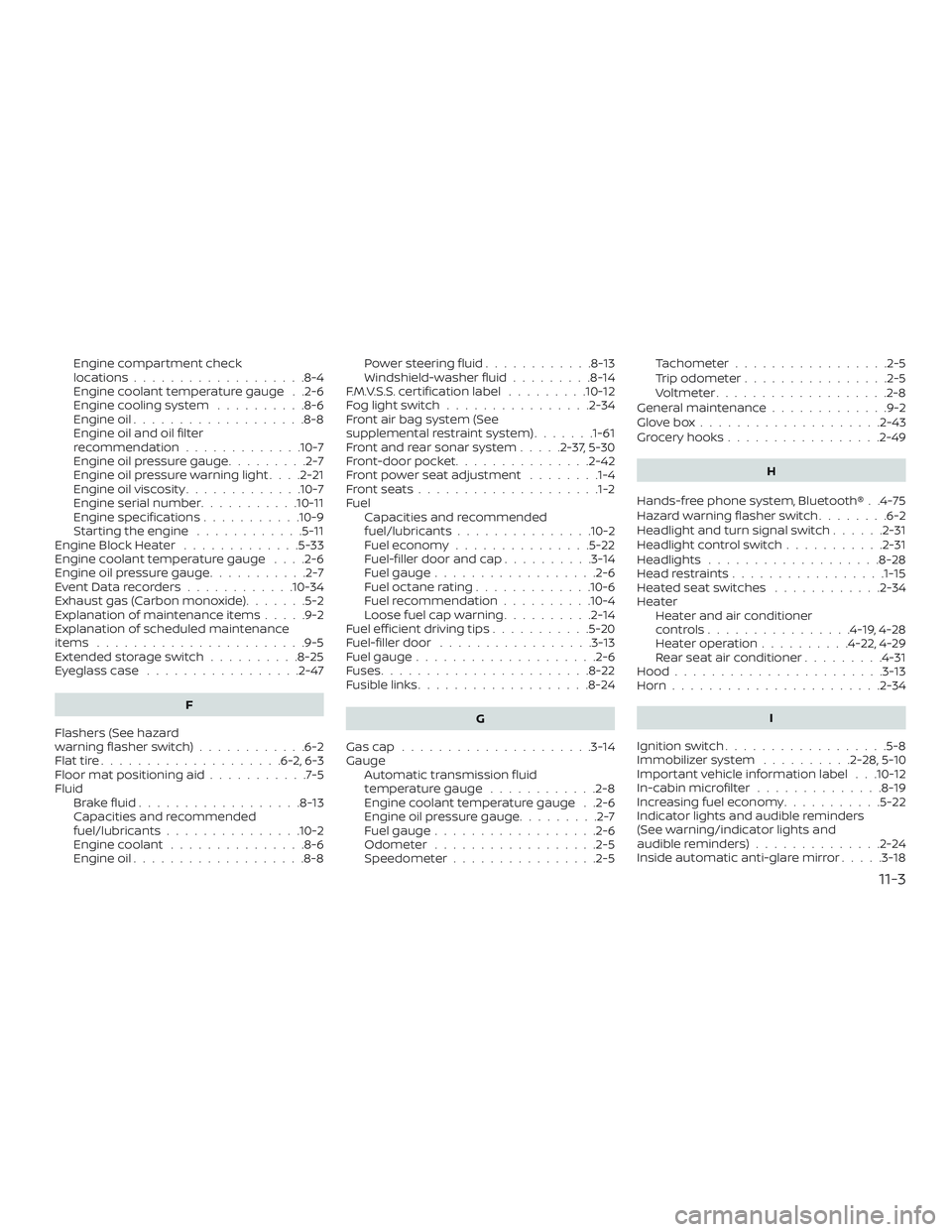
Engine compartment check
locations...................8-4
Engine coolant temperature gauge . .2-6
Engine cooling system..........8-6
Engine oil ...................8-8
Engine oil and oil filter
recommendation .............10-7
Engine oil pressure gauge .........2-7
Engine oil pressure warning light ....2-21
Engine oil viscosity .............10-7
Engine serial number ...........10-11
Engine specifications ...........10-9
Starting the engine ............5-11
Engine Block Heater .............5-33
Engine coolant temperature gauge ....2-6
Engine oil pressure gauge ...........2-7
EventDatarecorders............10-34
Exhaust gas (Carbon monoxide) .......5-2
Explanation of maintenance items .....9-2
Explanation of scheduled maintenance
items .......................9-5
Extended storage switch ..........8-25
Eyeglasscase .................2-47
F
Flashers (See hazard
warning flasher switch) ............6-2
Flattire....................6-2,6-3
Floormatpositioningaid...........7-5
Fluid Brakefluid..................8-13
Capacities and recommended
fuel/lubricants...............10-2
Engine coolant ...............8-6
Engine oil ...................8-8 Powersteeringfluid............8-13
Windshield-washer fluid
.........8-14
F.M.V.S.S. certification label .........10-12
Foglightswitch................2-34
Front air bag system (See
supplemental restraint system) .......1-61
Front and rear sonar system .....2-37,5-30
Front-door pocket ...............2-42
Front power seat adjustment ........1-4
Frontseats....................1-2
Fuel Capacities and recommended
fuel/lubricants...............10-2
Fuel economy ...............5-22
Fuel-filler door and cap ..........3-14
Fuel gauge ..................2-6
Fueloctanerating.............10-6
Fuel recommendation ..........10-4
Loose fuel cap warning ..........2-14
Fuel efficient driving tips ...........5-20
Fuel-filler door .................3-13
Fuel gauge ....................2-6
Fuses .......................8-22
Fusiblelinks...................8-24
G
Gascap .....................3-14
Gauge Automatic transmission fluid
temperature gauge ............2-8
Engine coolant temperature gauge . .2-6
Engine oil pressure gauge .........2-7
Fuel gauge ..................2-6
Odometer ..................2-5
Speedometer ................2-5 Tachometer
.................2-5
Trip odometer ................2-5
Voltmeter...................2-8
General maintenance .............9-2
Glovebox................... .2-43
Grocery hooks .................
2-49
H
Hands-free phone system, Bluetooth® . .4-75
Hazardwarningflasherswitch........6-2
Headlight and turn signal switch ......2-31
Headlightcontrolswitch...........2-31
Headlights...................8-28
Headrestraints.................1-15
Heated seat switches ............2-34
Heater Heater and air conditioner
controls................4-19,4-28
Heater operation ..........4-22,4-29
Rear seat air conditioner .........4-31
Hood .......................3-13
Horn.......................2-34
I
Ignition switch ..................5-8
Immobilizer system ..........2-28,5-10
Important vehicle information label . . .10-12
In-cabinmicrofilter ..............8-19
Increasing fuel economy ...........5-22
Indicator lights and audible reminders
(See warning/indicator lights and
audible reminders) ..............2-24
Inside automatic anti-glare mirror .....3-18
11-3
Page 421 of 426
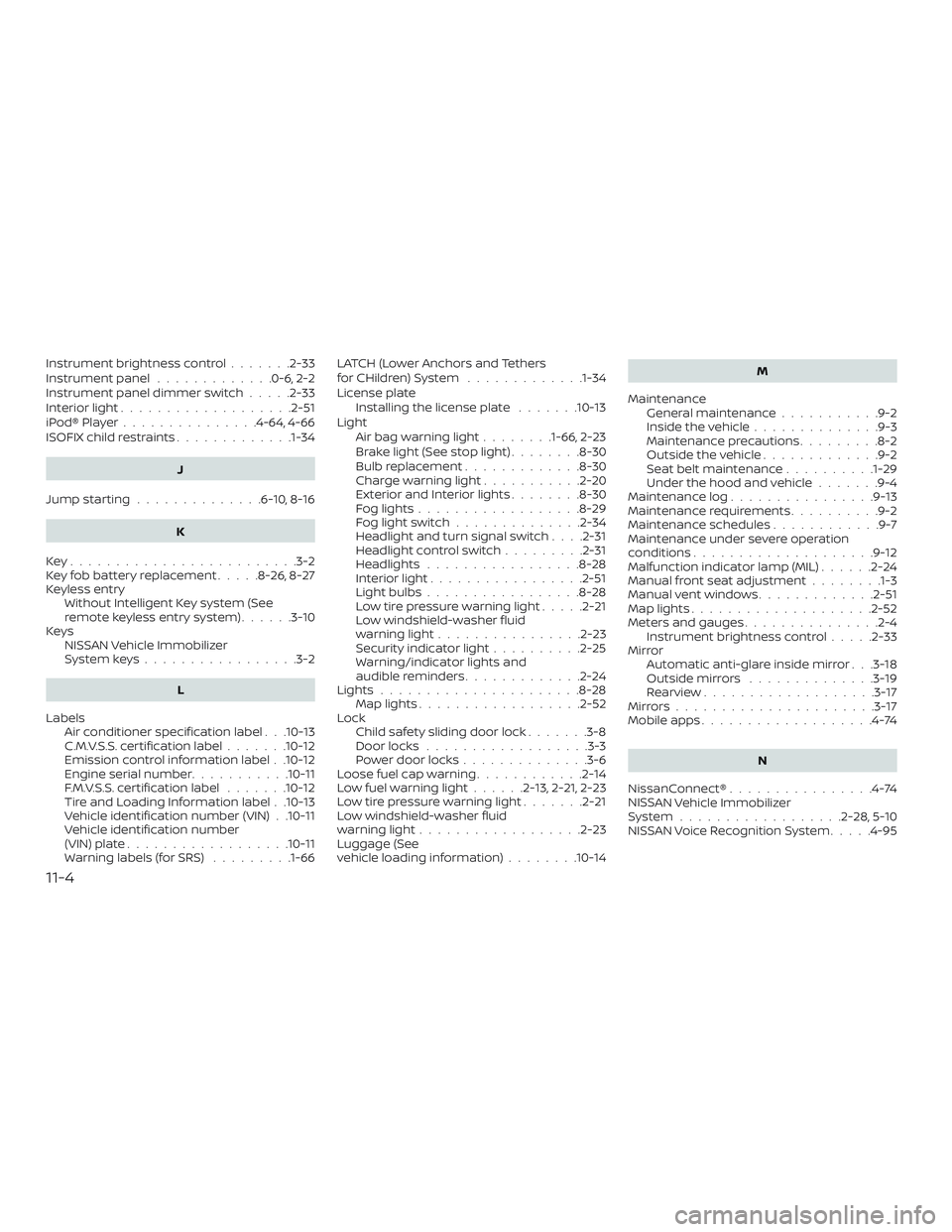
Instrument brightness control.......2-33
Instrument panel .............0-6,2-2
Instrument panel dimmer switch .....2-33
Interiorlight...................2-51
iPod®Player...............4-64,4-66
ISOFIX child restraints .............1-34
J
Jumpstarting..............6-10,8-16
K
Key.........................3-2
Key fob battery replacement .....8-26,8-27
Keyless entry Without Intelligent Key system (See
remote keyless entry system) ......3-10
Keys NISSAN Vehicle Immobilizer
Systemkeys.................3-2
L
Labels Air conditioner specification label . . .10-13
C.M.V.S.S. certification label .......10-12
Emission control information label . .10-12
Engine serial number ...........10-11
F.M.V.S.S. certification label .......10-12
Tire and Loading Information label . .10-13
Vehicle identification number (VIN) . .10-11
Vehicle identification number
(VIN)plate..................10-11
Warning labels (for SRS) .........1-66LATCH (Lower Anchors and Tethers
forCHildren)System ............
.1-34
License plate Installing the license plate .......10-13
Light Airbagwarninglight........1-66, 2-23
Brakelight(Seestoplight)........8-30
Bulb replacement .............8-30
Charge warning light ...........2-20
ExteriorandInteriorlights........8-30
Foglights..................8-29
Foglightswitch..............2-34
Headlight and turn signal switch ....2-31
Headlightcontrolswitch.........2-31
Headlights.................8-28
Interiorlight.................2-51
Lightbulbs.................8-28
Low tire pressure warning light .....2-21
Low windshield-washer fluid
warninglight................2-23
Security indicator light ..........2-25
Warning/indicator lights and
audible reminders .............2-24
Lights......................8-28 Maplights..................2-52
Lock Child safety sliding door lock .......3-8
Door locks ..................3-3
Power door locks ..............3-6
Loose fuel cap warning ............2-14
Lowfuelwarninglight......2-13,2-21,2-23
Low tire pressure warning light .......2-21
Low windshield-washer fluid
warninglight..................2-23
Luggage (See
vehicle loading information) ........10-14 M
Maintenance General maintenance ...........9-2
Insidethevehicle..............9-3
Maintenance precautions .........8-2
Outsidethevehicle.............9-2
Seat belt maintenance ..........1-29
Under the hood and vehicle .......9-4
Maintenance log ................9-13
Maintenance requirements ..........9-2
Maintenance schedules ............9-7
Maintenance under severe operation
conditions....................9-12
Malfunctionindicatorlamp(MIL)......2-24
Manual front seat adjustment ........1-3
Manual vent windows .............2-51
Maplights....................2-52
Meters and gauges ...............2-4
Instrument brightness control .....2-33
Mirror Automatic anti-glare inside mirror . . .3-18
Outsidemirrors ..............3-19
Rearview...................3-17
Mirrors......................3-17
Mobile apps ...................4-74
N
NissanConnect® ................4-74
NISS
AN Vehicle Immobilizer
System..................2-28,5-10
NISSAN Voice Recognition System .....4-95
11-4
Page 423 of 426
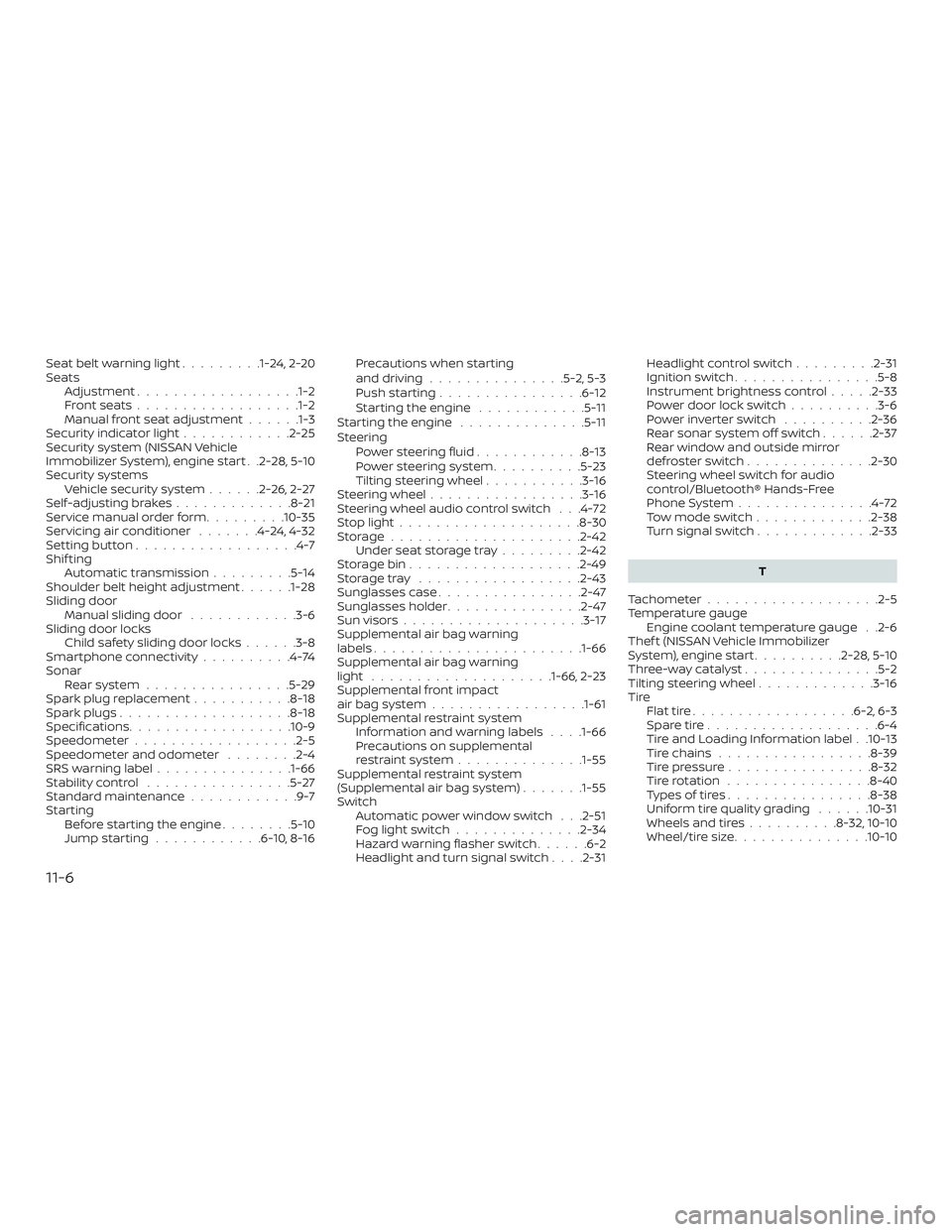
Seatbeltwarninglight.........1-24, 2-20
SeatsAdjustment ..................1-2
Frontseats..................1-2
Manual front seat adjustment ......1-3
Security indicator light ............2-25
Security system (NISSAN Vehicle
Immobilizer System), engine start . .2-28, 5-10
Security systems Vehicle security system ......2-26,2-27
Self-adjustingbrakes.............8-21
Service manual order form .........10-35
Servicing air conditioner .......4-24,4-32
Settingbutton..................4-7
Shif ting Automatic transmission .........5-14
Shoulder belt height adjustment ......1-28
Sliding door Manual sliding door ............3-6
Sliding door locks Child safety sliding door locks ......3-8
Smartphone connectivity ..........4-74
Sonar Rear system ................5-29
Spark plug replacement ...........8-18
Spark plugs ...................8-18
Specifications ..................10-9
Speedometer ..................2-5
Speedometer and odometer ........2-4
SRS warning label ...............1-66
Stability control ................5-27
Standard maintenance ............9-7
Starting Before starting the engine ........5-10
Jumpstarting............6-10,8-16 Precautions when starting
anddriving...............5-2,5-3
Push starting
................6-12
Starting the engine ............5-11
Starting the engine ..............5-11
Steering Powersteeringfluid............8-13
Powersteeringsystem..........5-23
Tilting steering wheel ...........3-16
Steering wheel .................3-16
Steering wheel audio control switch . . .4-72
Stoplight....................8-30
Storage.....................2-42 Under seat storage tray .........2-42
Storagebin...................2-49
Storagetray ..................2-43
Sunglasses case ................2-47
Sunglasses holder ...............2-47
Sunvisors....................3-17
Supplemental air bag warning
labels ...................... .1-66
Supplemental air bag warning
light ................... .1-66, 2-23
Supplemental front impact
airbagsystem................ .1-61
Supplemental restraint system Information and warning labels . . . .1-66
Precautions on supplemental
restraintsystem..............1-55
Supplemental restraint system
(Supplemental air bag system) .......1-55
Switch Automatic power window switch . . .2-51
Foglightswitch..............2-34
Hazard warning flasher switch ......6-2
Headlight and turn signal switch ....2-31Headlightcontrolswitch.........2-31
Ignition switch
................5-8
Instrument brightness control .....
2-33
Power door lock switch ..........3-6
Powerinverterswitch ..........2-36
Rear sonar system off switch ......2-37
Rear window and outside mirror
defrosterswitch..............2-30
Steering wheel switch for audio
control/Bluetooth® Hands-Free
Phone System ...............4-72
Tow mode switch .............2-38
Turn signal switch .............2-33
T
Tachometer ...................2-5
Temperature gauge Engine coolant temperature gauge . .2-6
Thef t (NISSAN Vehicle Immobilizer
System), engine start ..........2-28,5-10
Three-waycatalyst...............5-2
Tilting steering wheel .............3-16
Tire Flattire..................6-2,6-3
Spare tire ...................6-4
Tire and Loading Information label . .10-13
Tire chains .................8-39
Tire pressure ................8-32
Tirerotation ................8-40
Types of tires ................8-38
Uniform tire quality grading ......10-31
Wheels and tires ..........8-32,10-10
Wheel/tire size ...............10-10
11-6